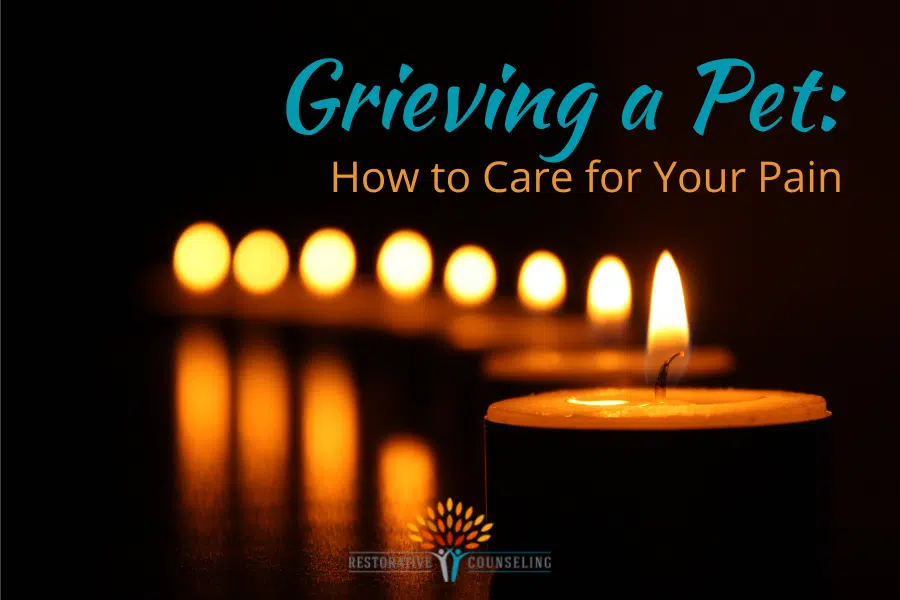Written by Katie Jackson-Griffin, LCPC
Recently, my family lost one of our cats, Mascarpone. He suddenly declined in health and was gone within a few weeks. It was an incredibly difficult time, in which we all struggled. I was coping with my own grief, while also supporting my husband and young daughter through the loss. I have lost pets before, which made me believe that I would be well-equipped to cope with this loss of companionship. However, no matter how many times a person experiences a loss, it rarely gets easier.
While grieving a pet, you can learn tools to help you cope with and carry the grief so that it doesn’t feel so heavy. Going through the grieving process is not a unique experience to me. Thus, here are some ways I have been caring for myself and my family that you may find useful as well.
We are here to support you while you grieve.
5 Ways to Express and Care for Your Grief
1. Remember that grieving a pet takes time
So often with grief, people judge how they are grieving. They may put a timeline on the grief. One might say, “I should be over this by now.” It’s understandable to want to be done with the grief; it’s painful. However, there is no right or wrong way to grieve. You can’t predict it. While that can be difficult to accept, it is also freeing to allow yourself the space and patience to experience the grief as it comes. Mantras such as “I am allowed to grieve”, “there is no timeline on grief”, or “I’m tired from feeling grief” can help ground you, while judgment of yourself can often make grief feel worse.
2. Know that all emotions are allowed
Again, there is no right or wrong way to grieve. You may feel sadness, anger, confusion, jealousy, and many other emotions. So often, we judge how we’re expressing these feelings, but all ways of expressing grief are “normal.” You might find yourself crying, smiling about the memories, or yelling in anger remembering what you have lost. It can be a bit of a roller coaster! When grieving a pet, it’s also completely natural to feel jealous that others continue to have their pets or haven’t had to endure this loss. Many can fear that this makes them a “bad” person, but jealously is an expression of pain. By normalizing that a mix of emotions may occur, this helps you honor the feelings and allows them to soften. Giving yourself kindness and compassion regardless of the emotions can help you more effectively cope.
3. Find ways to honor and spend time with the memories of your pet
The loss of your companion is profound. Your home is quieter than it should be. A main source of comfort for you is gone. You no longer have the same joy you had when your pet was with you. Most likely, you’re going to crave having them back only to remember that it isn’t possible. What you can do is be creative about how you still honor your pet. It can help to talk about them with your loved ones and share fun memories with others that knew them.
We had Mascarpone cremated and placed him in a special spot with his favorite toy. Looking at that spot makes me feel sad, but also makes me smile thinking about how much he loved that toy. It can be comforting to know that he is still here with our family.
Other ways to honor or spend time with your pet can be making a photo album/photo book of them, getting a painting done of them, or spending time in their favorite spot. For example, a friend of mine that lost her dog enjoyed walking on their favorite path and talking to her as if she were still there. It gave her a lot of comfort to feel connected to her dog in that way. Of course, none of these things can bring your companion back, but they can help ease your sadness and give you an opportunity to spend some time remembering your favorite times with them.
4. Keep it simple when explaining the loss to young children
When you’re struggling with grieving a pet yourself, it can be difficult to be there for others. But when you do have the energy, supporting others can be a useful way to grieve. It can be particularly difficult to talk to young children about pet loss. Before sharing the news with my young daughter, I prepared myself to repeat the same statement over and over. This is how young children process. While it was painful to say “Mascarpone died” or answer her questions of “Where is Mascarpone?” several times a day, I knew that it was what was needed for her brain to process the information. It can be useful to remember to “stick to the truth” and “keep it simple.” Short statements were all that she could understand instead of a long explanation.
We spent time feeling the emotions together, too. We cried together and hugged each other. It was helpful for her to see that it was okay for us to be sad. We could express that feeling and get through it together.
5. Find outlets for your love
Missing Mascarpone hasn’t just been about missing him, but also about missing having a pet in general. It is much quieter around our home now. While we don’t quite feel ready for another cat, it has been helpful to consider where else I can put that extra love that I have to give.
Some of my clients that I have supported through pet loss have chosen to volunteer at animal shelters, spend extra time with their friends’ pets, or do some dog walking or pet sitting in their free time. I have definitely been giving my friends’ pets some extra love and attention! The desire to nurture an animal doesn’t go away with a pet’s passing, so redirecting that desire to other areas can be very satisfying before you’re ready for another pet.
It has been a few months since Mascarpone passed away. Our family still misses him a lot, but the pain and grief have softened. Being intentional about my grieving process has helped me move through it.
The Restorative Counseling team can support you through the process of grieving a pet
Asking for extra help when grieving a loss is always an option. Grief can be hard to navigate, and you deserve support. Restorative Counseling can help! To learn more about how we can assist you as you move through difficult times, request an appointment today.

Hi, I’m Katie!
I use HAES and DBT approaches to help people overcome their challenges with low self-esteem, anxiety, and depression. Read more about me.
Follow Restorative Counseling
Sign up for our newsletter

